Copyright (c) Iraj Bashiri, 1997 
|
Copyright (c) Iraj Bashiri, 1997 
|
Capital of Tajikistan. Between 1929 and 1961, the city of Dushanbe was called Stalinabad. The city of Dushanbe grew out of the village of Dushanbe, located in the Hissar Valley. Records show that as early as 1676, on each Monday of the week (dushanbe), villagers from the surrounding areas brought their produce to market at this spot. In 1907, Dushanbe served as a summer resort for the Bek of Hissar; in 1920, it housed Amir Alim Khan. The ousted Amir of Bukhara stayed in Dushanbe and cooperated with the Basmachis until he had to leave the region. From Dushanbe, he fled to Afghanistan in 1921, the year the town was freed from the Basmachis as well. After 1921, Dushanbe became the administrative center of Eastern Bukhara.
Dushanbe is divided into four administrative zones: Rah Ahan, Markazi, Oktiabr, and Frunze. Varzab, a suburb of Dushanbe, used to serve as one of the prominent recreation areas for the former Soviet Union. At the present time, the city serves as both the administrative center of the republic of Tajikistan and the republic's largest industrial and cultural center.
Dushanbe's main educational centers include the Academy of Sciences of Tajikistan, the State University of Tajikistan in the Name of Lenin, Tajikistan Polytechnique, and the Shevchenko Pedagogical Institute.
Influenced by the Soviets, the Russians in particular, the Tajiks have developed a wonderful modern Opera Ballet theater and a number of art-related institutes, museums, and studios, all centered in the city of Dushanbe. The city also houses the Firdowsi Library, a major library with an impressive collection of medieval Islamic manuscripts.
Dushanbe is connected to Termez, in Uzbekistan, by rail and to Kulab, Qurqanteppe, and Khorog, the administrative center of Gorno-Badakhshan, by car. Due to the mountainous terrain of the region, travel by plane and helicopter often is preferred to travel by car.
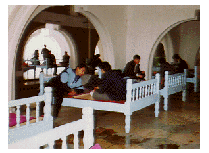
Walking down the streets of Dushanbe, a number of special features attract your attention. A prominent one is the teahouse or the chaikhana. You realize you are near a chaikhana when you hear the music filling the air and when you see the many colorful benches that invite the customers to take a few minutes of rest, drink tea and listen to the gossip of the day. In addition to tea and sweets, kabob and rice, are often also served.
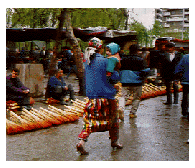
The delightful clothes of the men and women from the villages (kishlaks) is another interesting feature. Men wear the traditional jama (a knee-long jacket) tied at the waist with a colorful mianband (kerchief). Their taqi (skullcap) with its paisley design, distinguishes the wearers by region. Women wear a kurta, made of soft, colorful, bright silk, and a shalvar (long pants) with decorative cuffs (sheraz). Women also wear hats with their national costume. The hats, especially those imported from Bukhara and Badakhshan, are either embroidered or decorated with precious stones. Village women mostly wear colorful rusaris (scarf) tied in the back and worn in a decorative manner more like a hat than for cover as a veil. Farmers and herders wear a special heavy boot over their usual shoes. The older generation wear long Islamic cloaks and turbans. Many of the older people wear beards; they are referred to as aksakals (Turkish, lit. white beard) or muy sapids (Tajik, lit. white hair).
A feature of Dushanbe not liked by Westerners is related to some green patches of dried spit one comes across on the sidewalk. These patches are made by those who, like Westerners who chew tobacco, chew nas. A greenish substance produced by grinding the leaves of the nas plant, plaster, a couple of other ingredients into a fine powder. The nas is placed under the tongue and sucked. The saliva is spit on the sidewalk.
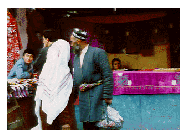
Dushanbe has two main bazaars: Barakat and Shamansur. A third bazaar in the region of the new micro rayons is exclusive to that population. During the summer, the bazaars teem with vegetables, fruits, flowers, and people. In winter, they are all but deserted. Bread, meat, and dried fruits are about all one can buy.
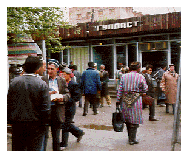
Walking down the alleys of Dushanbe, one may come across places that are set up like chaikhanas but have no kitchen attached to them. These are family organized tuy sessions, celebrating a wedding, a circumcision, or a graduation. Food, almost always osh, is prepared on the premises and is offered to all attending. Depending on the nature of the ceremony, appropriate music entertains the guests.
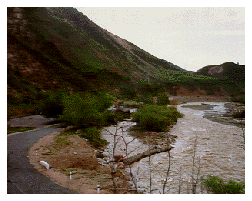
The one spot that all Tajiks want to take you to see is outside Dushanbe. It is called Varzab. It is a delightful place--a valley with grass and trees as far up as the eye can see, and a narrow but turbulent brook of blue but foamy water at the bottom. Various catering places, serving mostly kabob and fish, dot the side of the brook. Your hosts will bring bread, vodka, and dried nuts to complete what the caterers at the cafe offer. Discussions, almost always, are centered around the beauty of Varzab, a unique spot in the world, as far as your hosts are concerned. The Tajiki language, great poets, representative poetry, and Tajikistan's achievement in the area of the arts are other subjects of discussion.
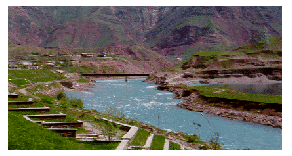
Primarily Sunni (Hanafi) Muslims, the Tajiks are placing more and more emphasis on Islam. The city has a main religious center in which the mufti resides and a large number of mosques of various sizes. Some of these, like the Sar-i Asia mosque are well-known and well-attended. Others are located in back alleys must be sought out. The best indicator of their existence, of course, as in any other Islamic city, is the call for prayer before sunrise.
Almaty
Bishkek
Tashkent
Ashgabat